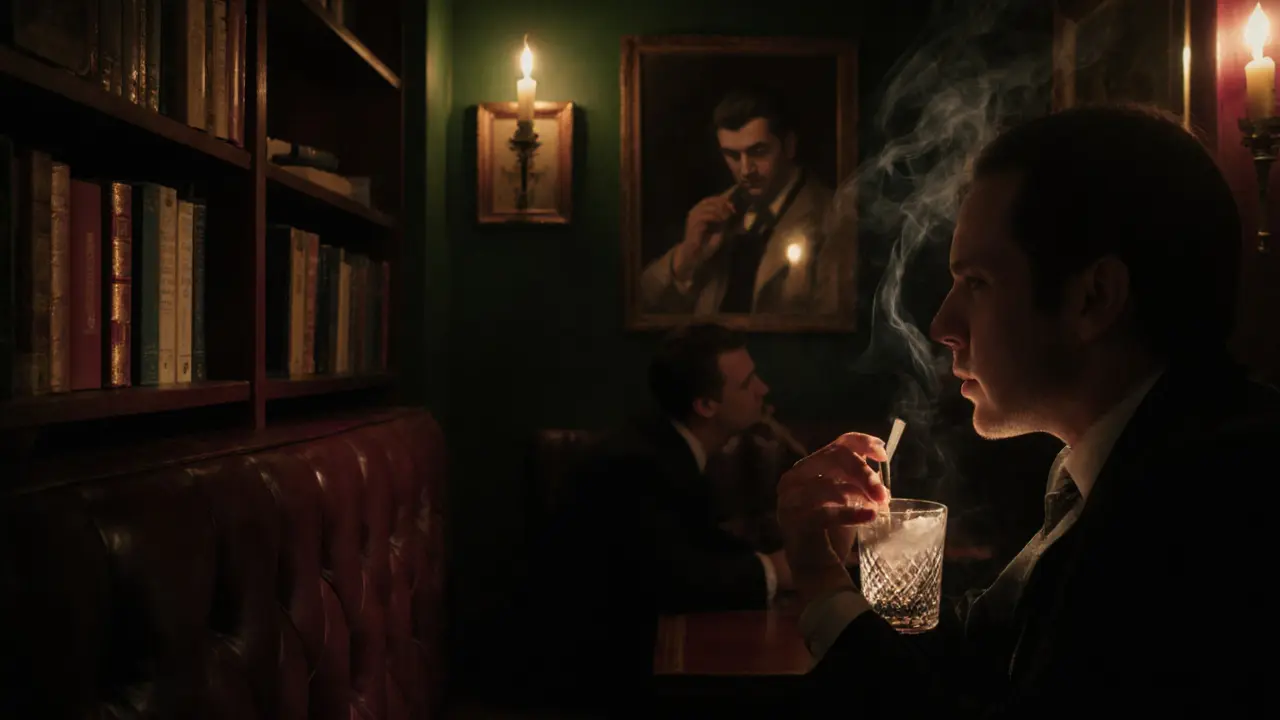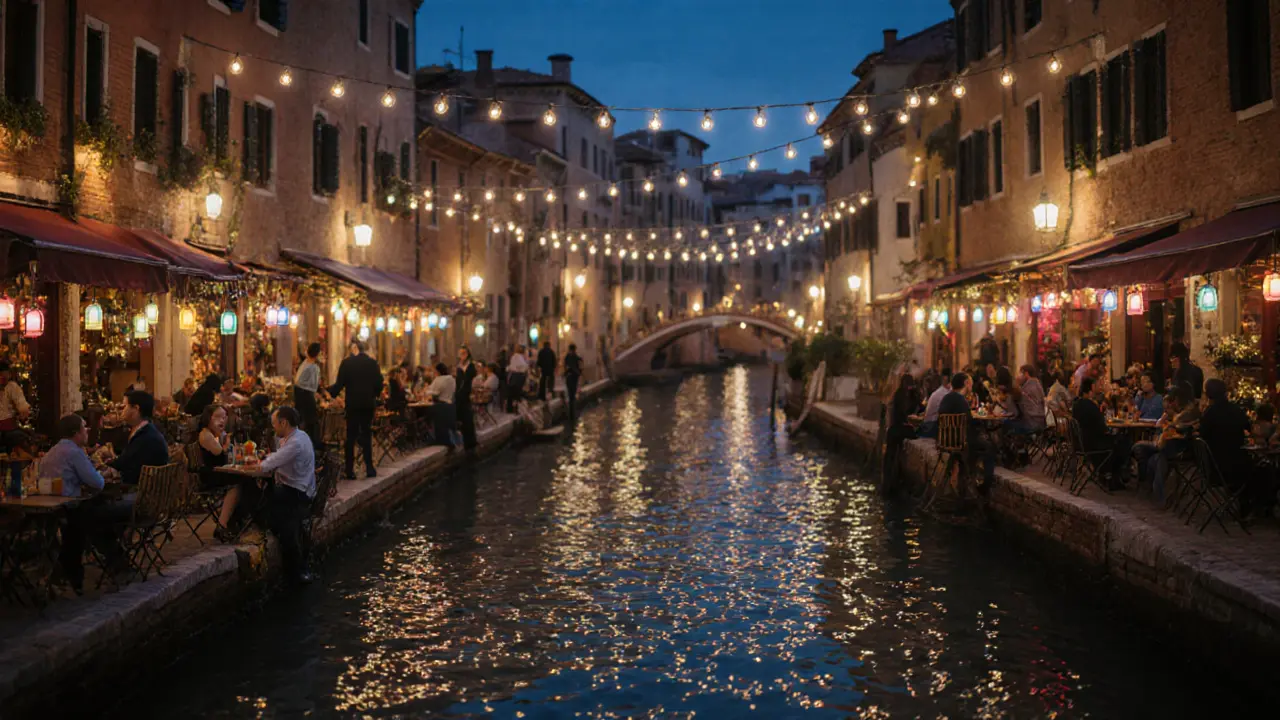Milan doesn’t sleep-it just changes outfits.
Most visitors think of Milan as fashion runways and Michelin-starred restaurants. But when the sun goes down, the city sheds its polished suit and slips into something wilder. You’ll find jazz lounges tucked behind unmarked doors, rooftop bars with skyline views that cost less than a designer handbag, and clubs where the bass hits harder than the metro during rush hour. This isn’t just partying. It’s a cultural rhythm you didn’t know you were missing.
Start in Navigli: Canals, Cocktails, and City Lights
Head to the Navigli district after 7 p.m. and you’ll see why locals call it Milan’s living room. The canals glow under string lights, and every step along the water is lined with bars that spill out onto cobblestone sidewalks. La Bicocca is the spot for craft cocktails made with local gin and herbal liqueurs. Order the Amarelo-a bitter-sweet mix of amaro, lemon, and elderflower-and watch the crowd shift from young professionals to artists and musicians as the night rolls on.
Don’t miss Bar Basso, where the original Negroni was invented in 1945. It’s still the best in the city. The place doesn’t look like much-small, dim, wood-paneled-but the drink is a masterclass in balance. If you want to keep going, cross the bridge to Bar San Vittore. It’s louder, cheaper, and packed with students. Their aperitivo from 7 to 10 p.m. gives you unlimited snacks with any drink. Think arancini, crostini, and fried zucchini. You’ll eat more here than you did at dinner.
Brera After Dark: Where the Intellectuals Party
Brera feels like a secret until it doesn’t. By day, it’s galleries and boutiques. By night, it’s wine bars with vinyl spinning and poets reading in corners. Bar Basso’s little brother, Il Baretto, is where Milan’s writers and designers unwind. No menu-just tell the bartender what mood you’re in. They’ll mix you something unexpected: maybe mezcal with smoked salt, or a white wine infused with rosemary and orange peel.
If you’re looking for live music, Teatro degli Arcimboldi hosts jazz nights on Thursdays. The crowd is older, quieter, but the talent? World-class. You’ll hear musicians from New York, Rio, and Tokyo playing in a room that feels like a 1920s Parisian cellar. Tickets are €15. It’s worth every euro.

Clubs That Actually Move: From Zona Tortona to Porta Genova
Milan’s club scene isn’t about glitz. It’s about sound, space, and sweat. If you want to dance until 6 a.m., skip the tourist traps near the Duomo. Go to La Bolognese in Porta Genova. It’s not on any map. You find it by following the bass. Inside, the walls are painted black, the floor is sticky, and the DJ spins underground techno from Berlin and Milan. No VIP section. No dress code. Just people who came to lose themselves.
For something more experimental, try Officine Grandi Riparazioni (OGR). It’s a former train repair shop turned cultural hub. On weekends, it becomes a warehouse party with three floors of music: house, experimental, and ambient. The sound system is built by engineers who work with museums. You’ll feel the bass in your ribs. Entry is €12 after midnight. Bring cash. Cards don’t always work.
And if you’re into underground hip-hop or Italian rap, Spazio 99 in Zona Tortona is the place. The crowd is young, diverse, and loud. The DJs don’t play Top 40-they play tracks from Milan’s own producers. You’ll hear beats made in garages and apartments. It’s raw. It’s real. And it’s the heartbeat of Milan’s youth culture.
Hidden Gems: Rooftops, Speakeasies, and Late-Night Eats
Not every great night needs a dance floor. For a quiet moment with a view, head to Terrazza Aperol on the top of the Porta Nuova skyscraper. It’s not the fanciest, but the skyline of Milan at 11 p.m. with a spritz in hand? Unbeatable. The crowd is mostly locals. No selfies. Just silence and stars.
Looking for a secret? Find Il Gatto Nero behind a bookshelf in a quiet alley near Piazza Cordusio. Knock three times. The bouncer will ask what book you’re reading. Say “The Stranger” and you’re in. Inside, it’s dim, leather booths, and cocktails named after Italian poets. The bartender remembers your name if you come back. You will come back.
And when you’re hungry after the clubs? Trattoria da Giacomo opens at 1 a.m. and stays open until 5 a.m. Their risotto alla Milanese is creamy, saffron-rich, and served with a glass of red wine. It’s not fancy. But it’s the only thing that’ll fix you after three hours of dancing.

What to Wear, When to Go, and What to Skip
Milanese nightlife has rules. They’re not written down, but you’ll feel them.
- Wear something sharp but not flashy. No sneakers with socks. No baseball caps. Italians notice details.
- Aperitivo is from 7 to 10 p.m. Arrive after 10 and you’ll pay full price for drinks with no snacks.
- Clubs don’t open before midnight. Don’t show up at 10:30 p.m. You’ll be the only one there.
- Don’t go to clubs near the Duomo unless you want to pay €25 for a watered-down gin and tonic while surrounded by tourists.
- Friday and Saturday nights are packed. If you want space, go on a Thursday.
And here’s the biggest mistake tourists make: thinking Milan’s nightlife is like Ibiza or Berlin. It’s not. It’s slower. Sharper. More thoughtful. You don’t come here to get wasted. You come here to feel alive.
When the Night Ends: Where to Catch a Ride or Sleep
The metro stops at 1:30 a.m. After that, you’re on your own. Uber works, but it’s expensive. Taxis are easier to find near Porta Genova and Navigli. Ask for a taxi nero-the black cabs. They’re regulated. The ones with yellow lights? Skip them.
If you’re staying late and don’t want to fight for a ride, book a room at Hotel Spadari Al Duomo. It’s quiet, central, and has a 24-hour front desk. You can stumble in at 4 a.m. and no one will blink.
Is Milan nightlife safe at night?
Yes, Milan is one of the safest major cities in Italy for nightlife. Stick to well-lit areas like Navigli, Brera, and Porta Genova. Avoid isolated alleys after 2 a.m., and don’t leave drinks unattended. Pickpockets exist, but they target distracted tourists-not locals. If you’re cautious, you’ll be fine.
What’s the average cost for a night out in Milan?
You can have a great night for €30-€50. Aperitivo with snacks: €15. A club entry: €10-€15. A cocktail: €12-€18. A late-night meal: €15. Skip the tourist bars near the Duomo-they charge double for the same drink. Stick to local spots, and you’ll get more value.
Are there any age restrictions for clubs in Milan?
Most clubs require you to be 18 or older. Some upscale or underground venues set the limit at 21. Always carry ID. Even if you look older, bouncers check. No ID, no entry. There are no exceptions.
Do I need to book tables at Milan clubs?
Only for special events or weekends at OGR or La Bolognese. For regular nights, just show up. Most places don’t take reservations. The vibe is casual. Waiting in line is part of the experience. If someone offers to get you in without waiting, walk away. It’s likely a scam.
What’s the best time to arrive at a Milan club?
Midnight to 1 a.m. is ideal. Clubs don’t heat up until then. Arrive too early, and you’ll be the only one. Arrive after 2 a.m., and the best music is over. The sweet spot is when the crowd hits, the lights dim, and the DJ drops the first deep track. That’s when Milan comes alive.
Final Tip: Don’t Rush It
Milan’s nightlife isn’t a checklist. It’s a slow burn. Sip your drink. Listen to the music. Talk to the person next to you. The best moments aren’t on Instagram-they’re the ones you didn’t plan. That’s why people come back. Not for the clubs. Not for the cocktails. But for the feeling that, for one night, you belonged here.
